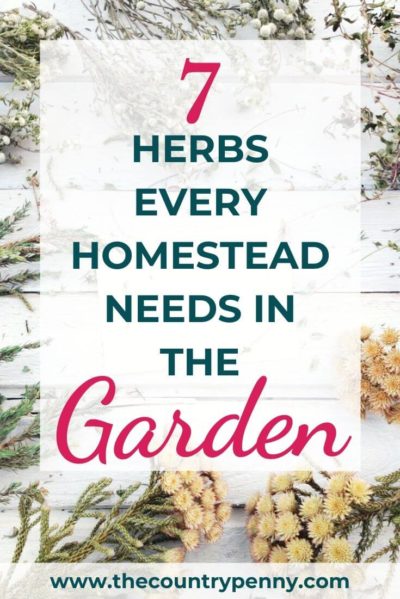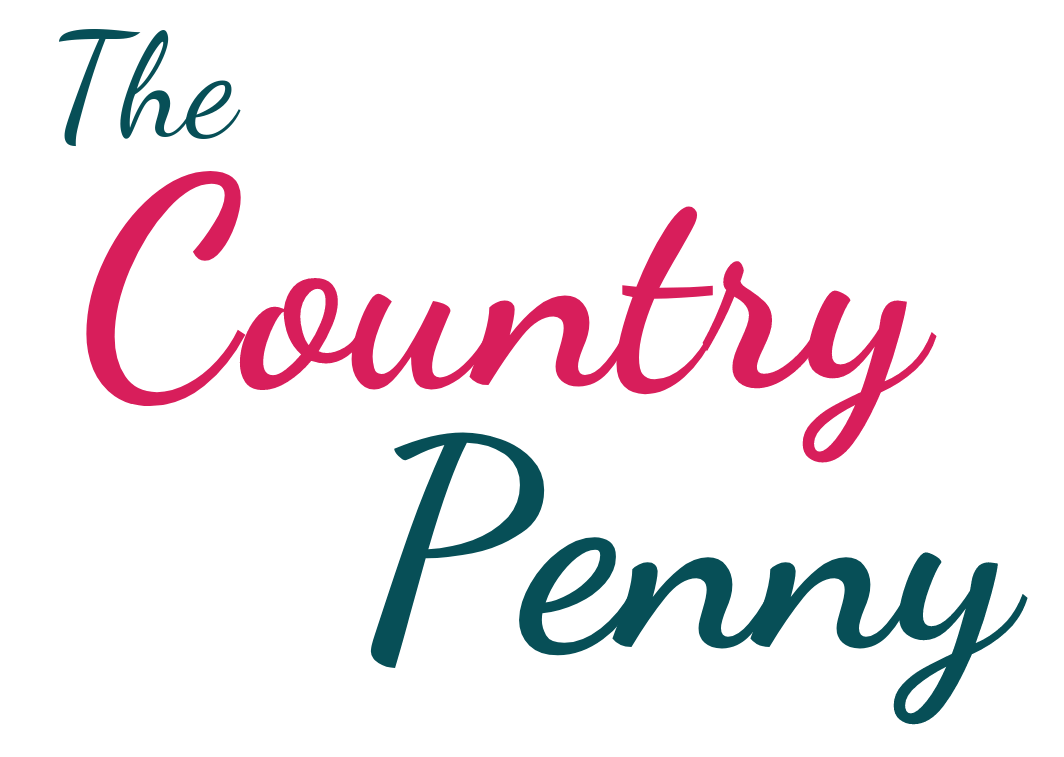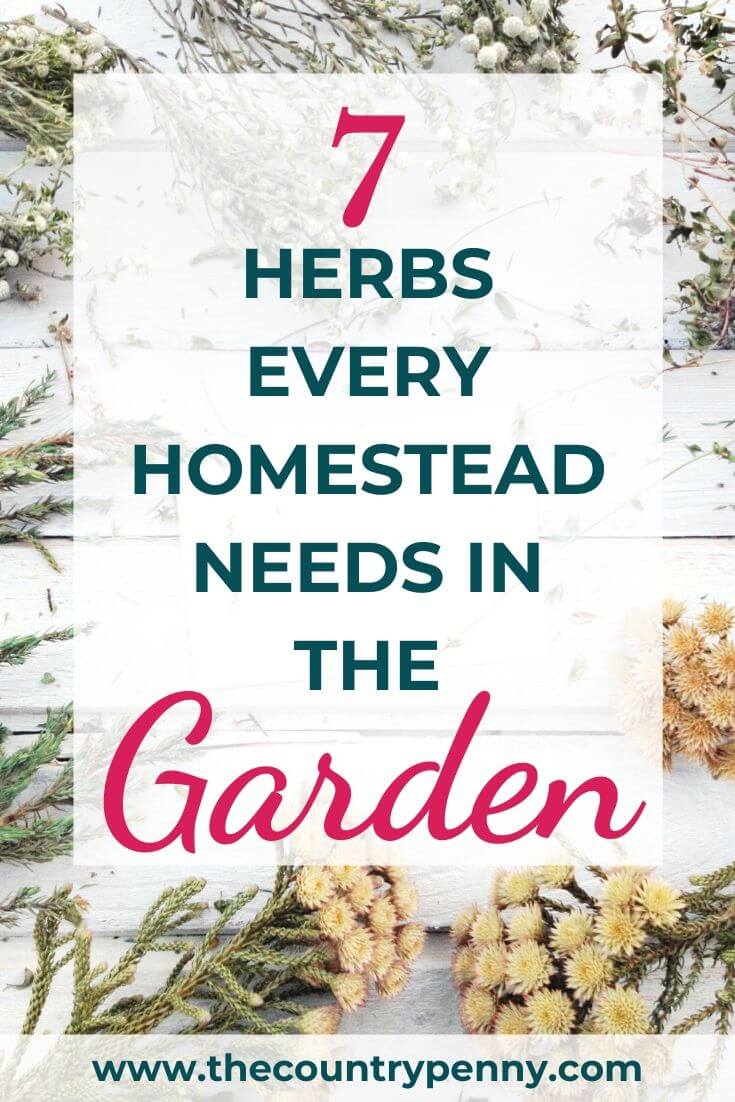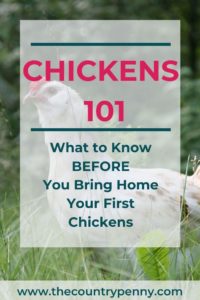Don’t have time to read it now? Pin it for later!
Growing herbs is one of the fastest and easiest ways to produce your own food. Most herbs can be harvested within a month or two of planting and will continue producing for most of the growing season. You can even grow herbs in containers to harvest year-round.
In general, herbs require very little care and thrive in even the worst soil. If you are just starting to venture into gardening growing your own herbs can be a great way to get started.
These are my top seven kitchen herbs for beginning and experienced gardeners alike.
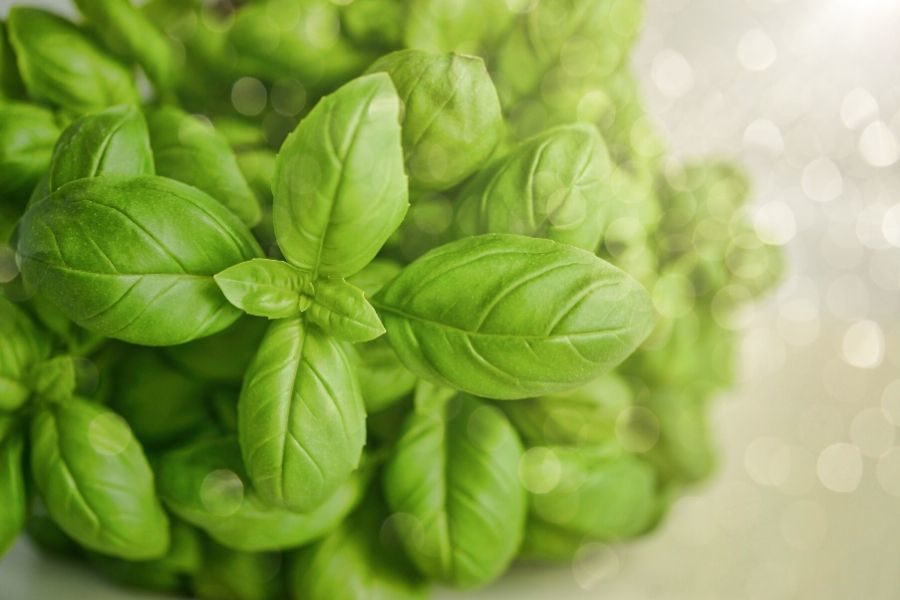
Basil
Basil is one of my favorite fresh kitchen herbs!
While basil can be dried it has much more flavor when used fresh. Fortunately, basil can be grown easily in pots as well as outside, making it easy to have fresh basil on hand all year.
Unlike many herbs, Basil is not drought resistant and likes to be watered daily when it is hot, but take care to keep water off the leaves when you can since it can cause them to develop brown spots or fungal issues.
Basil likes full sun, so if you plant it indoors make sure to choose a sunny window for best results. It can be grown from seed and it also transplants well. Basil is an annual, but it self-seeds easily in beds. It can tend to get bitter after flowering though, so don’t let it flower until the end of the season if you want it to self-seed outdoors.
Basil is robust so don’t be afraid to cut it back. It will bounce back better than before. It is easy to pinch back new growth, but if you have a lot of plants I like to use scissors or garden shears to cut it back heavily.
Basil can be cut back within four or five inches of the ground and it will grow back quickly. A big benefit of cutting basil back heavily is that it will form a sturdy, bushy plant instead of a tall spindly plant.
At a Glance
- Annual
- Moist Soil
- Full Sun
- Best used fresh, can be dried
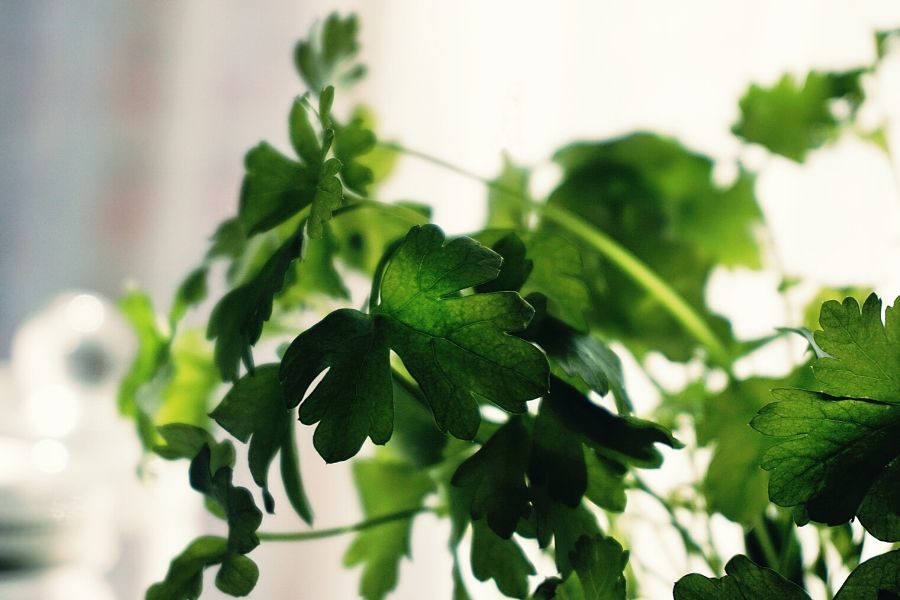
Cilantro
Cilantro is a requirement for pico de gallo, a fresh salsa that my family loves. It is pungent and peppery flavored and has just a little bite to it.
Cilantro can be grown indoors but likes a deep pot since it has a long taproot. Cilantro bolts (goes to seed) quickly when it gets hot but you can manage it somewhat by cutting it back when it begins to flower. It should also be cut back an inch when it is about three to five inches tall to form a bushier plant.
A better way to avoid bolting is to plant cilantro every two to four weeks throughout the growing season so that a new crop is ready when the old crop starts to bolt. Cilantro is an annual and will self-seed if given the chance. You can also harvest the seed, coriander, by cutting the flower heads when they start to turn brown and crack.
Then place the flower heads in a paper bag to finish drying. Once they are dry you can crush the flower heads to release the seeds. They are easy to separate from the flower head by pouring them into a new container in front of a fan. Since the seeds are heavy they will fall into the container while the crushed flower head will blow away.
Cilantro leaves should be used fresh because they lose their flavor when dried, but the coriander seed stores very well. You can also save the seed for planting the next year.
At a Glance
- Annual
- Moderate soil moisture
- Full Sun
- Leaves must be used fresh, seed can be stored
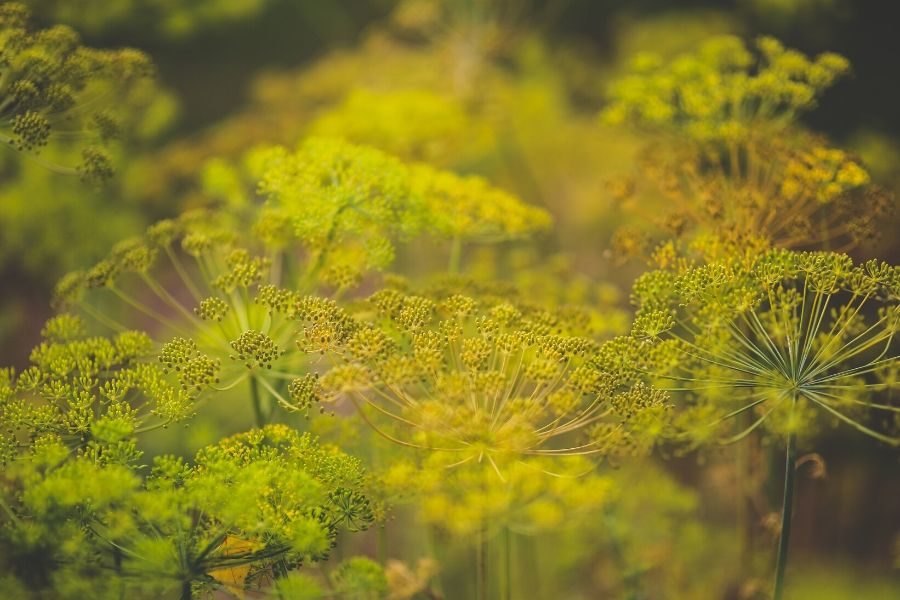
Dill
Dill’s most obvious use is for pickles, but it’s also delicious in dips, on fish, or my favorite way, in fresh cucumber sandwiches.
Dill is very easy to grow since it’s somewhat drought tolerant and prefers somewhat poor soil. This makes it an excellent choice to plant in areas that won’t grow more delicate plants. If you plant dill in your garden, make sure not to over-fertilize it. Dill likes full sun but will tolerate partial sun.
Both the feathery leaves and the seed can be used in cooking, and the seed can be harvested similarly to coriander seed. Since dill seeds are quite a bit smaller than coriander seeds, they can be more difficult to separate from the flower heads if crushed. Instead of crushing them, gently shake the paper bag containing the dry flower heads and most of the seed will fall, leaving the flowerheads intact.
Dill leaves, or dill weed, can be used fresh or dried. It is more flavorful when fresh, but the dried form is pretty good too. Most varieties of dill grow fairly large, making it a poor choice as a container plant. There are some smaller varieties, but dried dill has enough flavor that I don’t bother to grow dill year-round.
At a Glance
- Annual
- Moderate to dry soil
- Full Sun
- Used fresh or dried, leaves and seeds may be used
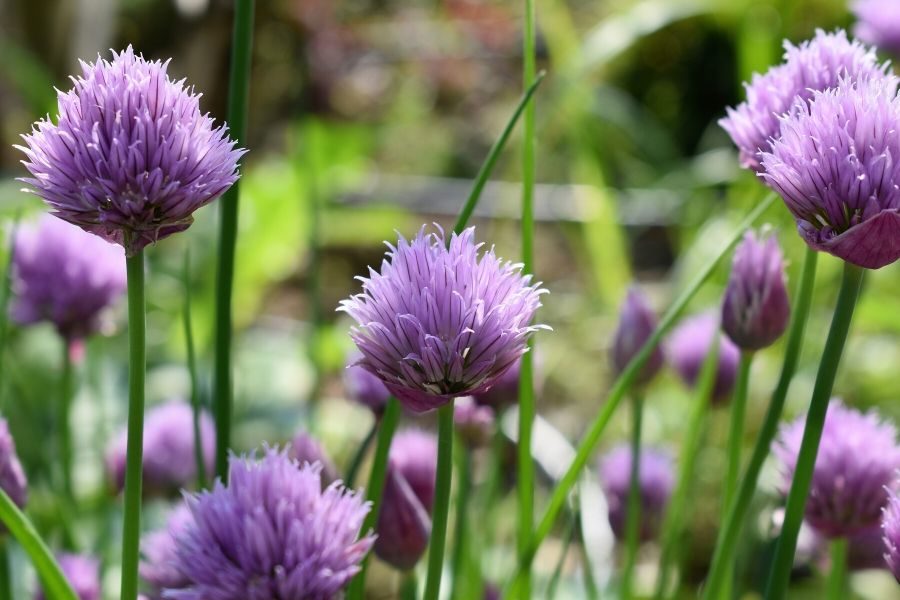
Chives
I first helped to harvest chives with my grandma when I was a little girl, and they have always had a soft spot in my heart.
Chives are a perennial plant in almost all climates, and they are very hardy. They also have the bonus of being incredibly pretty with their pink or white flowers, which are edible as well. Chives can blend in easily in a front flowerbed or they bring a pop of color to the garden.
They are somewhat drought resistant preferring damp to dry soil and are happy in full to partial sun. They can be grown from seeds, bulbs or starts and will grow into spiky clumps. These clumps can be divided to create more plants, making chives easy to expand to new areas without becoming invasive.
Chives don’t like to have wet feet, so make sure to let the soil dry out between waterings. Chives dry beautifully and will keep their flavor for quite a while. They also grow in a pot easily, though they do have a strong scent whenever they are bumped or cut.
I like the smell, but if you are very sensitive to onion or garlic smells you may not want to grow chives indoors.
At a Glance
- Perennial
- Moderate to dry soil, let soil dry before watering
- Full to partial sun
- Used fresh or dry, flowers and leaves are edible
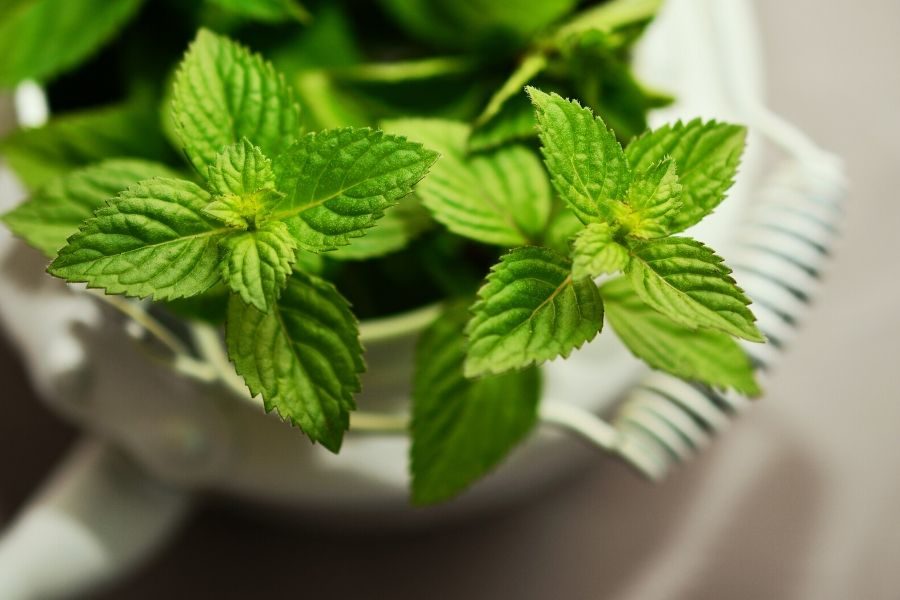
Mint
Mint and I have a love-hate relationship.
I love that it is so hardy, it thrives almost anywhere and is impossible to kill. Unfortunately, this also means it can and will take over your whole garden. Mint is very, very invasive, could probably survive a nuclear strike, and is almost impossible to remove once it’s started to spread.
Mint prefers to spread via underground runners, so it can be contained in a raised bed or a pot fairly easily. If you pinch off flowers it won’t produce seed, and in any case, I haven’t had much trouble with the seed escaping the pots.
Mint is great for sweet dishes, teas, and can be used in savory dishes, such as lamb or pork. There are tons of different varieties of mint, from spearmint and peppermint to chocolate mint. Fresh mint is much more flavorful than dried, and since it grows so well in pots I think it’s worth growing inside over the winter.
Mint can be grown from cuttings or starts. If you live in an extremely arid climate mint can be contained in a bed separate from the rest of your garden since it likes moist soil. A word of caution though, if you live in an arid climate but have wet spring or fall weather your mint will escape from the beds and begin to spread very quickly.
Mint tolerates a wide range of light conditions, from full sun to mostly shade, however, it likes partial sun the best.
At a Glance
- Perennial
- Moist, but not wet soil
- Full sun to partial shade
- Best fresh, can be used dry but not as flavorful
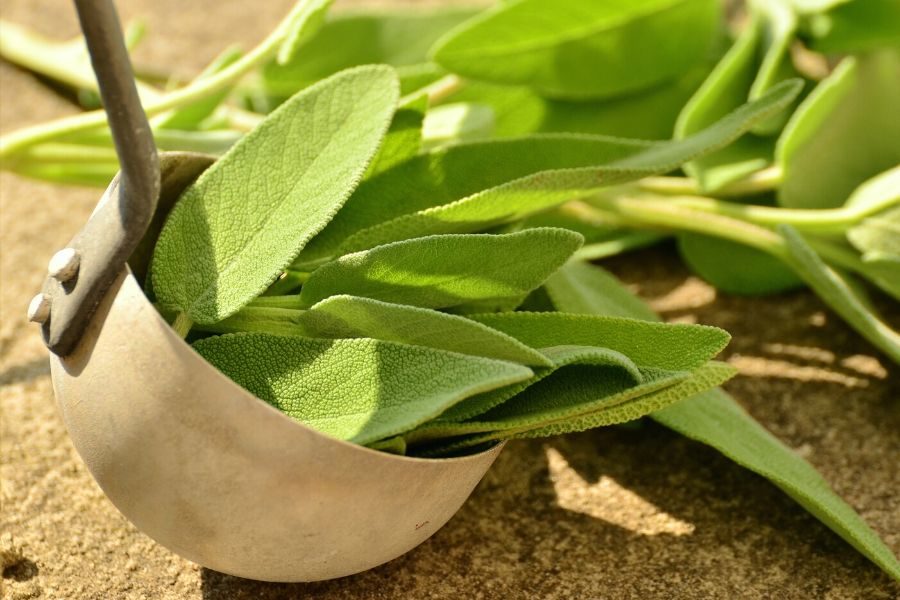
Sage
Sage is related to mint, but while it can be invasive under perfect conditions, it is much easier to control than mint is. If you want to keep it contained it is best to pot it or plant it in a tall raised bed, but I like to grow it in an herb garden where it has room to spread.
Sage is a pretty plant, with silvery green fuzzy leaves that will fit into a flowerbed beautifully. Sage is a hardy perennial that is very drought tolerant and prefers dry soil. Don’t overwater your sage, let the soil dry out well before watering unless you have just planted it. The first-year water frequently until the plants are well established.
Sage likes full sun the best. Sage can be grown from seed, but it is much easier to grow from a cutting or a start. Sage is used in savory dishes like stuffing, on turkey or pork, and is especially delicious when used to flavor sausage. Sage dries well but has an amazing flavor when used fresh. It can also be frozen with olive oil to preserve the fresh flavor.
Don’t overharvest the first year of planting sage, because it is a perennial it will need the energy from the leaves the first year to get established.
At a Glance
- Perennial
- Dry soil once established
- Full sun
- Used fresh, dried, or frozen
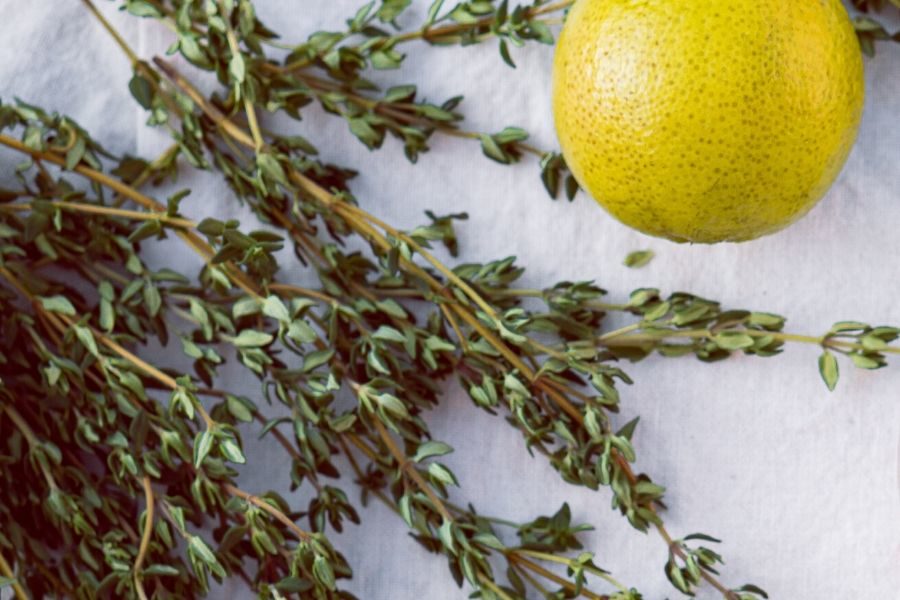
Thyme
Thyme is a hardy perennial that comes in both bush or sprawling forms. The sprawling forms tend to have extremely small leaves and are better as an ornamental plant than they are for use in the kitchen. The bush forms are pretty and can go in flowerbeds or in the garden. Thyme is much better behaved than mint or sage and doesn’t usually spread aggressively.
Thyme prefers dry soil once established and likes to have full sun. It isn’t a fussy plant and grows well in poor soil. It is very drought tolerant as well and is a great plant for people who kill plants since it is so hardy.
Thyme can be grown from seed, starts, or cuttings. I prefer to grow it from starts since the plants can be divided easily once they are established. Thyme should be cut back in the fall and woody stems should be removed each year to encourage it to put out new growth.
Thyme is excellent fresh and a whole sprig of thyme can be added to dishes. Thyme also dries well and can be frozen in olive oil.
At a Glance
- Perennial
- Dry soil
- Full sun
- Used fresh, dried, or frozen
Herbs are an easy introduction to gardening and can be a great place to start when you are beginning to grow your own food for the very first time. They are easy to grow and don’t take a lot of time to care for. These seven herbs are perfect for beginning gardeners or they’re a great way for more experienced gardeners to get started growing herbs for the very first time.
What are your favorite herbs to grow? Comment below, I’d love to hear from you!
Just starting a new garden? Go check out this post on how we started a brand new weed free garden!
